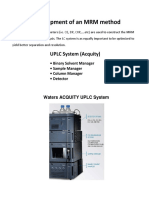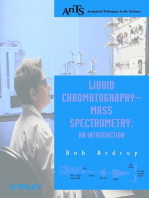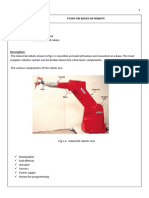Iron Experiment XW
Iron Experiment XW
Uploaded by
pathisharmaCopyright:
Available Formats
Iron Experiment XW
Iron Experiment XW
Uploaded by
pathisharmaOriginal Title
Copyright
Available Formats
Share this document
Did you find this document useful?
Is this content inappropriate?
Copyright:
Available Formats
Iron Experiment XW
Iron Experiment XW
Uploaded by
pathisharmaCopyright:
Available Formats
Chemistry 201 Laboratory
Fall 2008
page 1 of 4
Experiment: Determination of Iron in a Ferrous Ammonium Sulfate Sample (Fe) This experiment involves the determination of the percentage of ferrous iron in an unknown sample by redox titration with potassium dichromate solution as the standard using: (i) ferroin indicator (ii) potentiometric titration. The net ionic balanced equation for the titration is: Cr2O72- + 6 Fe2+ + 14 H+ ---> 2 Cr3+ + 6 Fe3+ + 7 H2O PROCEDURE: DO NOT DRY THE (Fe) SAMPLE IN THE OVEN DO NOT DRY THE POTASSIUM DICHROMATE (K2Cr2O7) IN THE OVEN Use reagent grade potassium dichromate, K2Cr2O7 as the primary standard. Weigh accurately 0.75 g of the primary standard into a 250 mL volumetric flask and dilute to volume with distilled water. The preparation of the unknown solution is as follows: Weigh accurately (by difference) a 2.5 g portion of UNDRIED ferrous sample into about 30 mL 1:1 sulfuric acid solution (15 mL conc. acid added slowly to 15 mL water with rapid stirring; solution temperature will reach 80C) in a 250 mL beaker with vigorous stirring (Operate in hood!). Cool, transfer quantitatively to a 100 mL volumetric flask, and make up to volume. Any precipitate if present will dissolve with shaking. ENSURE MINIMUM CONTACT OF THIS SOLUTION WITH OXYGEN. TITRATION: Do three (3) indicator titrations and one (1) potentiometric titration, not necessarily in that order. For the indicator titrations, 20.0 mL aliquots of this unknown solution are titrated with the K2Cr2O7 solution using ferroin as the indicator. The color change is from red to yellow green (best is bluish in color). Do a blank titration first in order to determine the color change. If the volume of your titrant is very far from 25 mL, you may adjust the aliquots of unknown solution proportionally to make the equivalence point closer to 25 mL. For the potentiometric titrations, use a pH meter in mV mode with a platinum indicator electrode and a calomel reference electrode (set to either (+) or (-) to have it fall within the scale; if it goes below 0, switch to make it return to scale). The ferroin indicator is not needed for this titration. Allow the dichromate titrant to drain into a 150 mL beaker provided with a magnetic stirrer. To simplify obtaining a first derivative curve plot, enter the titrant by an approximate, but precisely measured volume: e.g. If the end point occurs around 15 mL, add the following mL increments: 5, . . . 5, . . 2, . . 1, . .1, . .0.5, . .0.2, . . 0.1, . . 0.1, . . 0.05, . . 0.05, . . 0.05, . . 0.05, . . 0.1, . . 0.1, . . .0.2, . 0.5, . . .1, . . .1, . . 2, . . . 5, . . Exceed the end point by about 10 mLs. To determine the end point in the potentiometric titrations, plot the following curves : (i) E (mV) vs. volume (v in mL) of titrant, (ii) �E/�v (mV/mL) vs. average v (mL). Determine the end point from the latter (first derivative) curve. Compare the results of the two experiments.
Chemistry 201 Laboratory
Fall 2008
2-
page 2 of 4
Discarding Waste: dichromate (Cr2O7 ) is toxic to the environment. After the experiment, excess K2Cr2O7 and the analyte are to be discarded in the designated waste bottles located on the reagent bench. Concentrated sulfuric acid waste must be placed in the plastic, labeled container under the acid fume hood. Please ask the instructor or TA if you have any questions. Supplementary Appendix: DERIVATIVES OF CURVES: Acid-base, gravimetric, redox and complexometric titrations usually yield logarithmic curves in plots of the appropriate parameters versus volume of titrant added. (Note: pH and mV are examples of parameters which are logarithmic.). Sometimes, it is difficult to discern the endpoint of the titration, and it is useful to plot the first-derivative value versus the average volume because at the endpoint a sharp change of direction occurs. The tables below show the calculations needed to determine the first and second derivatives for raw data containing a set of v (mL) vs mV (note: v and mV are your recorded data). It is recommended that the calculations be done by computer using programs such as Excel. Table 1: First Derivative
�v (mL) --v2 - v1 v3 v2 v4 v3 �mV --mV2- mV1 mV3- mV2 mV4- mV3 1st Derivative Data �mV/�v (mL)-1 --(mV2- mV1)/( v2 - v1) (mV3- mV2)/( v3 v2) (mV4- mV3)/( v4 v3)
Point 1 2 3 4 ...
v (mL) v1 v2 v3 v4
mV mV1 mV2 mV3 mV4
vave (mL) --(v2 +v1)/2 (v3 +v2)/2 (v4 +v3)/2
Plot �mV/�v (y axis) versus average volume, vave (x-axis) will give you a first-derivative curve. A second-derivative curve of, i.e. �[�mV/�v]/�vave versus average volume, vave, yields an even more accurate plot than the first-derivative curve because a transverse line across the volume axis is obtained at the endpoint. Table 2: Second Derivative
1st Derivative Data vave �mV/�v -1 (mL) (mL) ----(mV2- mV1)/( (v2 v2 - v1) +v1)/2 (mV3- mV2)/( (v3 v3 v2) +v2)/2 (mV4- mV3)/( v4 v3) (v4 +v3)/2 �vave (mL) ----(v3 +v2)/2(v2 +v1)/2 (v4 +v3)/2(v3 +v2)/2 �[�mV/�v] (mL)-2 ----(mV3- mV2)/( v3 v2)-(mV2-mV1)/( v2 - v1) (mV4- mV3)/( v4 v3)-(mV3-mV2)/( v3 v2) 2nd Derivative Data �[�mV/�v]/�vave (mL)-2 vave (mL) ----[(mV3-mV2)/(v3-v2)(mV2-mV1)/(v2-v1)]/[ (v3 +v2)/2-(v2 +v1)/2] [(mV4- mV3)/( v4 v3)(mV3- mV2)/( v3 v2)]/[ (v4 +v3)/2-(v3 +v2)/2] ----[(v2+v1)/2 +(v3 +v2)/2]/2 [(v3+v2)/2 +(v4 +v3)/2]/2
Point 1 2 3
...
Chemistry 201 Laboratory Examples of the derivative curves:
Fall 2008
page 3 of 4
CALCULATING % Fe in the unknown sample: We note that the 2 half reactions are: a) Fe2+ --> Fe3+ + eb) Cr2O72- + 6 e- ---> 2 Cr3+ (unbalanced) Since at the equivalence point, # equivalents of Fe2+ = # equivalents of Cr2O72 We can write: (#moles of Fe2+) = 6 x (# moles of Cr2O72) MFe2+VFe2+ = 6MCr2O7VCr2O7 and: %Fe = =
FURTHER READING: 1. R. B. Dean and W. J. Dixon, Anal. Chem., 23, 636 (1951) 2. W. J. Dixon, Ann. Math. Stat., 22, 68 (1951) 3. J. S. Fritz and G. H. Schenk, Jr. , Quantitative Analytical Chemistry 4th Ed., Allyn and Bacon, Boston (1979) 4. L. Meites, ed., Handbook of Analytical Chemistry. McGraw-Hill, N.Y. (1963).
Chemistry 201 Laboratory Informal report: Experiment: Determination of Iron Name: Locker #
Fall 2008 Date submitted: Time submitted: Values obtained: (1) (indicator method) (2) (3) (potentiometric method) (4) Average value = % % % % % %
page 4 of 4
(if applicable) Standard deviation=
--------------------------------------------------------------------------------------------------------------g K2Cr2O7 used for standard solution = Show calculations: [K2Cr2O7] = Titration of unknown Fe ore: g Fe ore (unknown) = Titrations: I mLs of titrant added to reach end point: % Fe in ore = %Fe Sample calculation: N.b. At equivalence point, milliequivalents, mEq of titrant, A =mEq analyte, B mEq Fe2+ = mEq Cr2O72-; #mols Fe = 6 �(#mols Cr2O72-) ; (g Fe)/(AWof Fe) = 6(MCr2O7VCr2O7) => (g Fe) = 6(MCr2O7VCr2O7)(AW of Fe) % Fe = (6 MCr2O7 VCr2O7) (AW of Fe) (fraction titrated) (100%)/ (g ore) MW of K2Cr2O7 = 294.22 g/mol, AW of Fe = 55.85 g/mol ______ ______ ______ ______ g (Ferroin indicator method) II III (Potentiometric method) IV M g
You might also like
- Mass Spectrometry Dry Lab CHM 1021Document7 pagesMass Spectrometry Dry Lab CHM 1021himaNo ratings yet
- ACQUITY Cleaning Procedure For MS SystemsDocument4 pagesACQUITY Cleaning Procedure For MS SystemsTubagusNo ratings yet
- CABI Presentation - Yelitza Colmenarez - CPHD 2021Document30 pagesCABI Presentation - Yelitza Colmenarez - CPHD 2021CABINo ratings yet
- Vitamins McqsDocument4 pagesVitamins Mcqsmarchkot100% (1)
- Diana Eck Seeing The SacredDocument19 pagesDiana Eck Seeing The SacredExtraDriveNo ratings yet
- JCB - 3dx Kirloskar EngineDocument1 pageJCB - 3dx Kirloskar EngineDhru TiNo ratings yet
- Lec8 Chrom3 HPLCDocument14 pagesLec8 Chrom3 HPLCAnonymous Jlq5r8W1No ratings yet
- ChromatograaphyDocument16 pagesChromatograaphyAnonymous Jlq5r8W1No ratings yet
- Masslynx 35Document468 pagesMasslynx 35lehuuhaiNo ratings yet
- A Review On Stability Indicating HPLC Method DevelopmentDocument19 pagesA Review On Stability Indicating HPLC Method DevelopmentppiccoliniNo ratings yet
- Making Sense of The LCMS Data Differences - David WeilDocument65 pagesMaking Sense of The LCMS Data Differences - David WeilKhoranaNo ratings yet
- Unit 11 Complexometric Tit RationsDocument28 pagesUnit 11 Complexometric Tit RationsNeelakshi N Naik100% (1)
- MANUAL TIAMO 101-0003 - eDocument714 pagesMANUAL TIAMO 101-0003 - eteobaldo1964No ratings yet
- Performance, Productivity and Value - Combined: API 3200 Lc/Ms/Ms SystemDocument5 pagesPerformance, Productivity and Value - Combined: API 3200 Lc/Ms/Ms Systemdangerous0No ratings yet
- Questions On ISE - The AnswerDocument3 pagesQuestions On ISE - The Answerنيرمين احمدNo ratings yet
- 논문 - A stability-indicating HPLC method for the determination of glucosamine in pharmaceutical formulationsDocument7 pages논문 - A stability-indicating HPLC method for the determination of glucosamine in pharmaceutical formulationsjs_kim5781No ratings yet
- PharmaceuticsDocument9 pagesPharmaceuticsHARI HARA RAO GUJJARNo ratings yet
- SPE Method DevelopmentDocument22 pagesSPE Method Developmentalchemist90No ratings yet
- Circular Dichroism PDFDocument7 pagesCircular Dichroism PDFprakas.rao39695No ratings yet
- UPLC H Class Plus SpecificationDocument5 pagesUPLC H Class Plus Specificationchaerul.anwar554100% (1)
- Chromatography 1Document63 pagesChromatography 1Anonymous YvtugTulDNo ratings yet
- AasDocument2 pagesAasEarl Justine Delos Reyes100% (1)
- Method Development Anda Validation HLPC DithranolDocument6 pagesMethod Development Anda Validation HLPC DithranolTiago GonçalvesNo ratings yet
- The Theory of HPLC - Reverse Phase Chromatography - Reversed Phase HPLC of Ionizable SamplesDocument4 pagesThe Theory of HPLC - Reverse Phase Chromatography - Reversed Phase HPLC of Ionizable SamplesmostafaNo ratings yet
- VAM Uncertainty PDFDocument90 pagesVAM Uncertainty PDFiptNo ratings yet
- LC by DesingDocument12 pagesLC by DesingsudermanfitoNo ratings yet
- IDA TutorialDocument20 pagesIDA Tutorialhaben9036No ratings yet
- Tandem MS For Drug AnalysisDocument93 pagesTandem MS For Drug AnalysisrostaminasabNo ratings yet
- Gupta HPLCDocument90 pagesGupta HPLCRakesh Kotta100% (1)
- CEs-CDL-B5 Acids Bases and Salts-040620Document179 pagesCEs-CDL-B5 Acids Bases and Salts-040620hannah kwonNo ratings yet
- Mhra - GLPDocument24 pagesMhra - GLPRambabu komati - QANo ratings yet
- 4 Derivatization GC-HPLC PDFDocument100 pages4 Derivatization GC-HPLC PDFArmando Chávez RojasNo ratings yet
- Potentiometric TitrationDocument29 pagesPotentiometric TitrationAunjanue WaiteNo ratings yet
- Chromatography HPLCDocument16 pagesChromatography HPLCFilia YunizaNo ratings yet
- LC MSDocument69 pagesLC MSBrahmeshNo ratings yet
- Water For InjectionsDocument4 pagesWater For InjectionsAlvina Arum PuspitasariNo ratings yet
- Hydrogen Content of Gases by Gas ChromatographyDocument3 pagesHydrogen Content of Gases by Gas ChromatographyDavinNo ratings yet
- HPLC Method Development and Validation For Pharmaceutical AnalysisDocument10 pagesHPLC Method Development and Validation For Pharmaceutical AnalysisGururaaj NaikarNo ratings yet
- Development of MRM Method - MRM and Acquity Water SystemDocument8 pagesDevelopment of MRM Method - MRM and Acquity Water SystemoctavianistrateNo ratings yet
- LOD LOQ DeterminationDocument2 pagesLOD LOQ Determinationharunsarip0% (1)
- Extern Quinta-Analytica Waters 2695d Manual enDocument55 pagesExtern Quinta-Analytica Waters 2695d Manual enakka1No ratings yet
- Ait Raman Ms NMRDocument56 pagesAit Raman Ms NMRAditya YadavNo ratings yet
- Waters Brochure HPLCColumnsCapabilities 720003995frDocument30 pagesWaters Brochure HPLCColumnsCapabilities 720003995frWalid HaouasNo ratings yet
- Gedruckt: Instrumentation of HPLC DetectorsDocument40 pagesGedruckt: Instrumentation of HPLC DetectorsDimitri KinNo ratings yet
- Titration GuideDocument44 pagesTitration GuideMichel M.No ratings yet
- Method Development and Validation A ReviewDocument31 pagesMethod Development and Validation A ReviewElami TuncelNo ratings yet
- 50 Years of HPLCDocument6 pages50 Years of HPLCCamilo LaraNo ratings yet
- USP Medicines Compendium - Eflornithine Topical Cream - 2013-01-16Document3 pagesUSP Medicines Compendium - Eflornithine Topical Cream - 2013-01-16amin138irNo ratings yet
- The Impact of PH On HPLC Method Development: Separations at Low PH - Retention and SelectivityDocument6 pagesThe Impact of PH On HPLC Method Development: Separations at Low PH - Retention and SelectivityHikmah AmelianiNo ratings yet
- Raman SpectraDocument22 pagesRaman SpectraAnanda SelvamNo ratings yet
- 4500 System User Guide en PDFDocument138 pages4500 System User Guide en PDFHendri SaputraNo ratings yet
- Bevacizumab 21 A AdDocument11 pagesBevacizumab 21 A Adbangun baniNo ratings yet
- TocDocument11 pagesTocKwok Fai ChanNo ratings yet
- NMR PresentationDocument11 pagesNMR PresentationSai SridharNo ratings yet
- HPLC: An IntroductionDocument48 pagesHPLC: An IntroductionMukund SrinivasNo ratings yet
- Galaxie User Guide 91497500Document368 pagesGalaxie User Guide 91497500Muhammad Akbar FahleviNo ratings yet
- Agilent Webinar April 18 2019 Solutions For Light Hydrocarbons and GasesDocument44 pagesAgilent Webinar April 18 2019 Solutions For Light Hydrocarbons and GasesAhmed Abo FornNo ratings yet
- Seafast For Nexion IcpmsDocument2 pagesSeafast For Nexion Icpmsta quang khanhNo ratings yet
- Methods of Estimation of MultiDocument41 pagesMethods of Estimation of Multiapi-19786321100% (1)
- Chromatograhy: 289 Sandeep KaileyDocument44 pagesChromatograhy: 289 Sandeep KaileyVizit DubeyNo ratings yet
- Liquid Chromatography - Mass Spectrometry: An IntroductionFrom EverandLiquid Chromatography - Mass Spectrometry: An IntroductionNo ratings yet
- 11 Redox Comp-DispDocument7 pages11 Redox Comp-DisppathisharmaNo ratings yet
- 2 A Lab Manual 201301Document105 pages2 A Lab Manual 201301pathisharmaNo ratings yet
- Expt 6Document1 pageExpt 6pathisharmaNo ratings yet
- GA6 Iron Ore Titr Rev4 94Document3 pagesGA6 Iron Ore Titr Rev4 94pathisharmaNo ratings yet
- Chemistry FileDocument36 pagesChemistry FilepathisharmaNo ratings yet
- Iron in Mohr's SaltDocument3 pagesIron in Mohr's Saltpathisharma75% (4)
- Introduction To MagnetochemistryDocument46 pagesIntroduction To Magnetochemistrypathisharma100% (1)
- Especificaciones Motores de ArranqueDocument19 pagesEspecificaciones Motores de ArranqueVictor LuqueNo ratings yet
- IB 2 SL Atoms & RadioactivityDocument12 pagesIB 2 SL Atoms & RadioactivityJessica GuyNo ratings yet
- Pacheco Torgal Et Al. 2012Document6 pagesPacheco Torgal Et Al. 2012Like HalimNo ratings yet
- Modicon M238 Hardware GuideDocument166 pagesModicon M238 Hardware Guidesoitbrave6No ratings yet
- Shihlin SL3 User Manual - V1.03Document211 pagesShihlin SL3 User Manual - V1.03Mã Văn TriệuNo ratings yet
- Quiri - Imports of Eastern Transport Amphorae To TurinDocument21 pagesQuiri - Imports of Eastern Transport Amphorae To TurinutvrdaNo ratings yet
- Shwe Yee Win: Personal DataDocument3 pagesShwe Yee Win: Personal DataPyae PhyoeNo ratings yet
- Journey Towards PerfectionDocument7 pagesJourney Towards Perfectionapi-3738883No ratings yet
- Maximum Power Transfer Theorem Case 1 125274Document1 pageMaximum Power Transfer Theorem Case 1 125274akashdeep tickooNo ratings yet
- Contech Bridge BrochureDocument12 pagesContech Bridge BrochureCONTECHCPINo ratings yet
- Badminton England Risk Assessment: Hazard Consequence Control MeasuresDocument2 pagesBadminton England Risk Assessment: Hazard Consequence Control MeasuresdanielNo ratings yet
- Solar Company Profile.Document39 pagesSolar Company Profile.Meleckzedeck MetiliNo ratings yet
- PAW Fiction - Tired Old Man (Gary D Ott) - Survival StoryDocument308 pagesPAW Fiction - Tired Old Man (Gary D Ott) - Survival StoryBruce ArmstrongNo ratings yet
- Golden Tractate of Hermes TrismegistusDocument4 pagesGolden Tractate of Hermes TrismegistusHeatherNo ratings yet
- Model-Based Dose Calculation Algorithms in BrachytherapyDocument110 pagesModel-Based Dose Calculation Algorithms in BrachytherapytutorhowNo ratings yet
- Structurix Quality Assurance Tools BrochureDocument5 pagesStructurix Quality Assurance Tools BrochurePP043No ratings yet
- Labsheet Intersection Volume Studies PDFDocument17 pagesLabsheet Intersection Volume Studies PDFDdeqz Elina Bueno INo ratings yet
- Technical Manual For Single-Family Kit Art. KAE5061Document12 pagesTechnical Manual For Single-Family Kit Art. KAE5061DjoNo ratings yet
- Standard Proctor TestDocument8 pagesStandard Proctor TestGrace OdiamarNo ratings yet
- Compilation of Works IN World Literature: Submitted By: Pontanar, Jiezl Faith V. English 4-ADocument18 pagesCompilation of Works IN World Literature: Submitted By: Pontanar, Jiezl Faith V. English 4-ARonald SillanaNo ratings yet
- Pathsource ResumeDocument9 pagesPathsource Resumeafmrpairikvftz100% (1)
- X Science SQP 2018-19Document6 pagesX Science SQP 2018-19muthu100% (1)
- Astm c393 Testing FixtureDocument3 pagesAstm c393 Testing FixtureThales Favoretto PozzerNo ratings yet
- Robotics Lab Manual FinalDocument39 pagesRobotics Lab Manual FinalSanthosh100% (4)
- IB BIO 10.1 - MeiosisDocument21 pagesIB BIO 10.1 - MeiosisPerson AnonymousNo ratings yet
- Basic Knowledge KitchenDocument9 pagesBasic Knowledge KitchenDedhen HidayatNo ratings yet
































































































